This list is limited to sites I have visited (so you won't see a photo from the Prison Ship Martyrs Monument in Fort Greene, for instance). For each site, I also mention other neighborhood attractions. Enjoy!
The Bronx
Stockbridge Indian Memorial (Van Cortlandt Park)
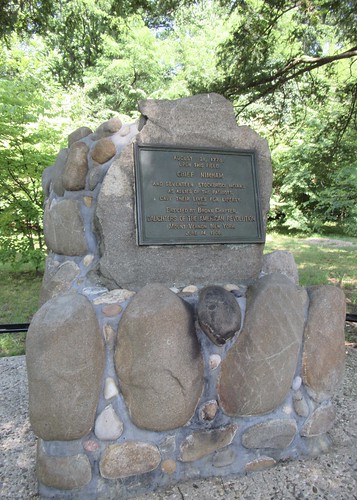
You'll find this memorial in the northeast part of Van Cortlandt Park. It's a tribute to a group of Native Americans, allied with the colonists, who died in August 1778 in a clash with an overwhelmingly larger number of British and Hessian troops. (Here's an article that goes into greater depth about the Stockbridge-Mohican community.)
In the neighborhood: Van Cortlandt Park is massive (one of the city's largest parks) and has golf courses, sports fields, and miles of hiking trails. The Van Cortlandt House Museum on the west side of the park dates from the 18th century, and during the Revolutionary War, both Washington and General William Howe, the commander of the British troops, made use of it. If you're in the area, you can also visit Woodlawn Cemetery, where a variety of historic figures are buried. The cemetery is close to the east side of the park.
Brooklyn
Battle Hill (Green-Wood Cemetery)
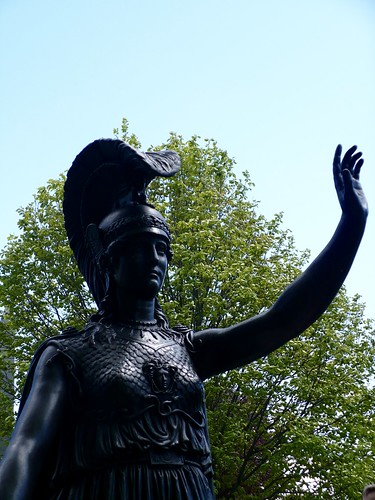
The Battle of Brooklyn (or the Battle of Long Island) in August 1776 almost resulted in Washington's irrevocable defeat; he made a narrow escape into Manhattan. Some of the fighting took place on Battle Hill, in what is now Green-Wood Cemetery. The photo shows a statue of Minerva, installed on the site (here's some background on the statue). The way she's positioned, it looks as if she's raising her hand to greet the Statue of Liberty, which you can see clearly from Battle Hill, the highest bit of natural land in Brooklyn.
In the neighborhood: Green-Wood Cemetery itself is worth exploring. Leonard Bernstein and Elias Howe are among the historic figures buried there. You'll also find the graves of many Civil War veterans, including this pair of brothers. Battle Hill itself is home to a Civil War monument. As for what to do once you're outside of the cemetery, I recommend visiting Prospect Park. Another nearby site connected to colonial and Revolutionary War history is the Old Stone House.
Fulton Ferry Landing (Brooklyn Bridge Park)
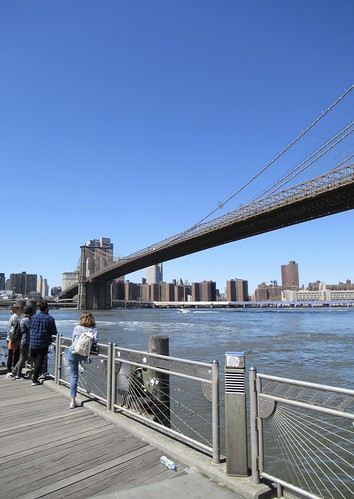
In 1642, the first ferry service between Brooklyn and Manhattan was established at this spot along the East River. On August 29, 1776, on facing defeat in the Battle of Brooklyn, Washington and thousands of his beleaguered troops retreated to Manhattan from the ferry landing (it was called Brookland Ferry Landing then).
In the neighborhood: Explore the Brooklyn Bridge Park Greenway, and walk through Brooklyn Heights and the DUMBO (Down Under the Manhattan Bridge Overpass) neighborhood. If you want to cross the Brooklyn Bridge on foot, know that the pedestrian entrance isn't on the water. You'll have to head inland. Here's a map of both the Manhattan and Brooklyn sides.
Lafayette Memorial (Prospect Park)

The Marquis de Lafayette is often referred to simply as Lafayette (either way is easier than his full name, Marie-Joseph Paul Yves Roch Gilbert du Motier). Shortly before his 20th birthday in 1777, the French aristocrat enlisted in the Continental Army and befriended Washington. He fought in Revolutionary War battles, including the Battle of Brandywine and at Yorktown, and helped convince the French government under Louis XVI to support the colonists. The Lafayette Memorial is located on the west side of Prospect Park.
In the neighborhood: I recommend spending time in Prospect Park (which was also a Battle of Brooklyn site). There's a zoo, a lake, a dog beach, a Ravine (apparently the only bit of forest left in Brooklyn), and Lefferts Historic House, an 18th-century farmhouse built in Flatbush but transplanted to Prospect Park for preservation (Peter Lefferts, who had it built, was a Brooklyn farmer and slave-owner who participated in the New York State Constitutional Convention). The Brooklyn Botanic Garden neighbors Prospect Park. If you're in the area, you can also visit the Brooklyn Museum and stop by Grand Army Plaza.
Plymouth Church (Brooklyn Heights)
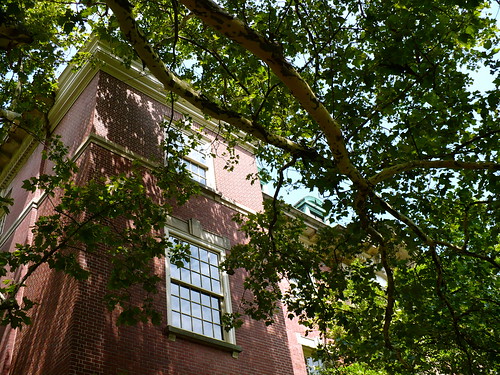
This church is strongly associated with the American Civil War, not the Revolutionary War. It was a safehouse on the underground railroad, and Henry Ward Beecher preached from its pulpit. Lincoln also prayed there. (Roughly a century later, so did Martin Luther King, Jr.) So why am I mentioning the church in this post? Because of its historic stained glass windows. They depict certain events and themes from U.S. history, including the colonial era and some of the principles the new nation was founded on. It's best to contact the church in advance about tours/viewings.
In the neighborhood: I've walked all around Brooklyn Heights (though usually not with American history in mind). It's a gorgeous neighborhood, and if you want to enjoy its beauty and visit some of the historic landmarks, check out this wonderful suggested walking route. If the weather is pleasant, make time to explore the Brooklyn Bridge Park Greenway along the East River. I also recommend visiting the NY Transit Museum, which is located underground in an old subway stop; among its exhibits are vintage train cars you can walk through.
Manhattan
Bennett Park (Hudson Heights)
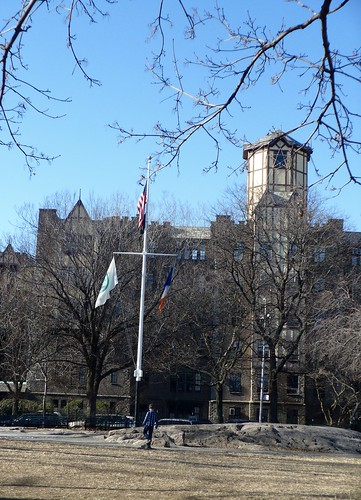
This park is roughly 265 feet above sea level, making it the highest natural land in Manhattan. During the Revolutionary War, Washington set up fortifications here before being driven out of Manhattan by the British in November 1776. This part of the conflict became known as the Battle of Fort Washington, and a memorial was installed at the park for the fort and its defenders.
In the neighborhood: I recommend heading north to Fort Tryon Park (described further down in this post). Another possibility is to cross the Hudson River on the pedestrian and bike path of the George Washington Bridge. Once on the other side, you can visit Fort Lee Historic Park (another Revolutionary War site) and go for a hike in the New Jersey Palisades Park. (Buses and Express jitneys are also available for crossing the bridge, if you use the newly renovated George Washington Bridge Bus Station.)
Bowling Green (Downtown)
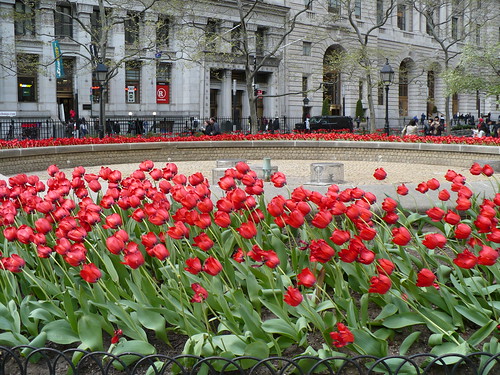
On March 21, 1770, a statue of King George III was erected at Bowling Green, a tiny park at the southern tip of Manhattan. It stayed up for a little over six years. On July 9, 1776, Washington held a public reading of the Declaration of Independence in NYC, and what happened next is described in this article (quick summary: the statue was torn down and beheaded, and much of it was melted down to make musket balls).
In the neighborhood: Along with the other Downtown sites mentioned in this post, visit the New York branch of the National Museum of the American Indian, which is located inside the Alexander Hamilton U.S. Custom House, right next to Bowling Green. You're also close to Battery Park, the ferry to the Statue of Liberty and Ellis Island, and the free Staten Island Ferry (which gives you great views of the Statue of Liberty and the city's harbor). At the north end of Bowling Green, you'll find tourists posing next to both the head and the rear end of the Wall Street Bull (Wall Street itself is a little bit north of the bull).
City Hall Park (Downtown)
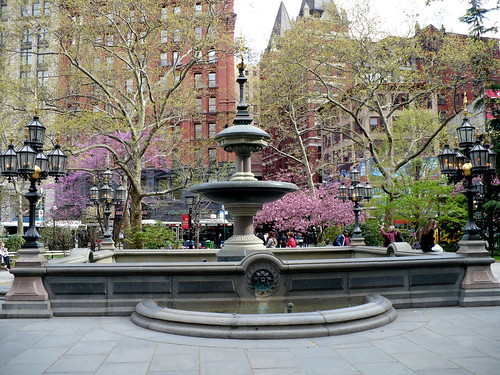
Once known as the Commons, the space in and around City Hall Park is now so tame and picturesque that you'll have to make an effort to imagine what it was like during the Revolutionary War. The British executed 250 prisoners of war in the vicinity of the park. The NYC Parks website shares an account of the park's history.
In the neighborhood: City Hall park places you close to the other Downtown sites I list here. Nearby, you'll also find City Hall itself and the African Burial Ground National Monument, a 17th and 18th century burial ground for free and enslaved black people that was rediscovered only in the early 1990s. If you want to head over to Brooklyn, the Manhattan entrance to the Brooklyn Bridge walkway is right by City Hall Park.
Federal Hall National Memorial (Downtown)

The building you see in this photo was built in the mid-1800s on the site of an earlier structure where important Revolutionary War activity and events critical to US government took place, including the meeting of the first U.S. Congress (which proposed the amendments to the Constitution that became the Bill of Rights) and George Washington's inauguration in 1789. (New York City was briefly the capital of the US.) Prior to the war, the Stamp Act Congress met here in 1765 and wrote this declaration to the king (to whom they still affirmed loyalty at the time).
In the neighborhood: Federal Hall is located on Wall Street. You can walk by the NY Stock Exchange (there are no tours of the trading floor for the general public). Federal Hall is also close to the South Street Seaport District and other Downtown sites I've listed here.
Fort Jay (Governors Island)
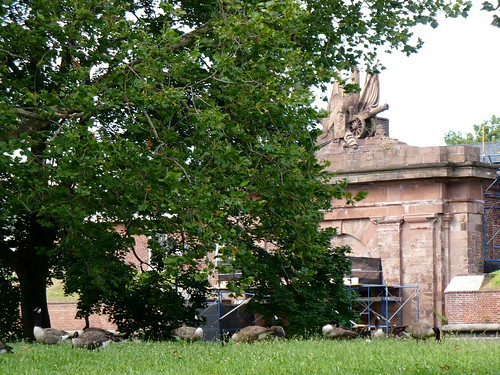
In the 1790s, Fort Jay was built on the site of an earlier earthen fortification used by the Continental Army to bombard British ships with cannon fire, before Governors Island and the rest of NYC came fully under British control. The fort was named after John Jay, the first Chief Justice of the Supreme Court. His achievements also include co-authoring The Federalist Papers and negotiating this important treaty with the British after the war.
In the neighborhood: Governors Island is fun. It has chickens and goats, bike paths, gigantic slides and a zip line, excellent views of the city and harbor, art projects, and another fortification, Castle Williams, built in the early 19th century. Ferries run every day of the week from the tip of Downtown Manhattan, close to where the Staten Island Ferry departs (but not from the same building/pier); another ferry, weekends only, connects Governors Island to Brooklyn Bridge Park.
Fort Tryon Park (Fort George)

The Battle of Fort Washington in November 1776 resulted in a defeat for the Continental Army, as they were pushed out of Manhattan. Part of this battle took place where Fort Tryon Park is located in Northern Manhattan. The park is named after William Tryon, New York's British governor at the time of the battle (Tryon's participation in the war included these raids in Connecticut). If you visit Fort Tryon Park, you'll notice that traffic flows through it on Margaret Corbin Drive, and that Margaret Corbin Circle stands at the main entrance. Corbin accompanied her husband in the Battle of Fort Washington, and when he was killed, she immediately took his place manning a cannon until she was wounded with disabling injuries. She became the first woman in U.S. history to receive a pension for military service.
In the neighborhood: I recommend exploring Fort Tryon Park. Take in the views of the Hudson River, visit the Heather Garden, and make time for The Cloisters, a group of medieval gardens and a collection of medieval art that includes The Unicorn Tapestries. North of Fort Tryon Park, you'll find Inwood Hill Park, where you can walk through the last remnant of natural forest on Manhattan and see what may have been the place where the Dutch bought Manhattan (the location and even the nature of the transaction aren't so clear though).
Fraunces Tavern (Downtown)
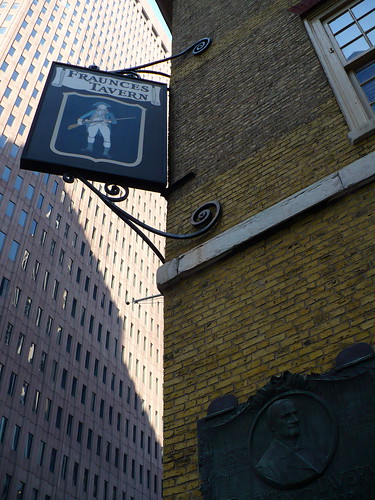
In 1762, Samuel Fraunces opened Queen's Head Tavern, which in the coming years would serve as a meeting place both for colonial Patriots (including the Sons of Liberty) and for Loyalists. (At the tavern, a number of escaped slaves who had joined the British military as Loyalists petitioned for certificates from the British granting them passage out of the US at the war's end.) In December 1783, Washington delivered a farewell to his officers in the tavern's Long Room.
In the neighborhood: Check out the other Downtown Manhattan sites listed in this post. Another one that's close to Fraunces Tavern is the Vietnam Veterans Plaza.
Hamilton Grange (Hamilton Heights in Harlem)
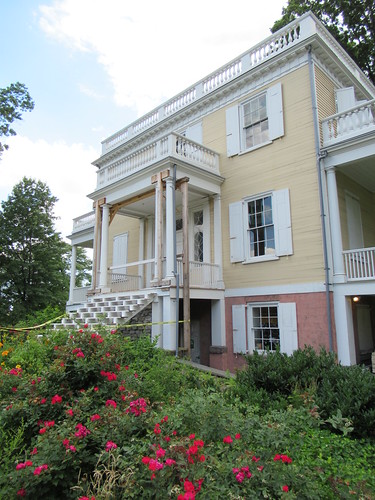
Alexander Hamilton possessed an estate of 32 acres in Upper Manhattan. (At the time, Upper Manhattan was basically countryside.) The construction of his two-story Grange was completed in 1802, and Hamilton died two years later. The Grange has been relocated twice and now sits in St. Nicholas Park, in the Hamilton Heights neighborhood. Here's a nice online tour of the interior.
In the neighborhood: Do yourself a favor and visit the City College Campus right next to Hamilton Grange. The architecture, which includes hundreds of grotesques, each with its own personality, makes it worthwhile. Hamilton Grange is a short distance from two historic black churches: the Abyssinian Baptist Church and Mother African Methodist Episcopal (AME) Zion Church. And, across the street from Hamilton Grange, you'll find a statue of Alexander Hamilton at St. Luke's Episcopal Church.
Lafayette and Washington Statue (Lafayette Square in Morningside Heights)
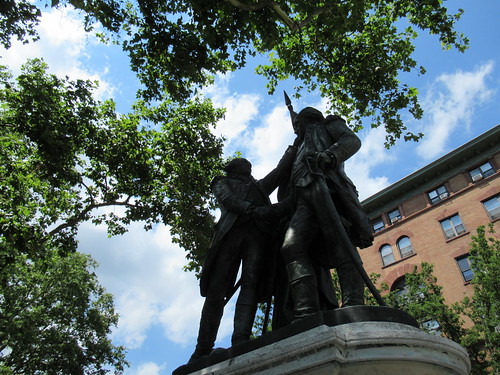
Here's an interesting article in Smithsonian Magazine about the relationship between Washington and Lafayette. In the statue on Morningside Heights, they're clasping hands, and the sculptor, Frédéric-Auguste Bartholdi, minimized the height and age difference between them. (Bartholdi is the sculptor who designed the Statue of Liberty.)
In the neighborhood: The campus for Columbia College is a short walk from here. (Columbia is one of the oldest colleges in the US. It was founded as King's College in 1754.) Lafayette Square is also right next to Morningside Park (and the side of the park with the small waterfall and pond). Roughly ten blocks north of Lafayette Square, you'll find the Apollo Theater in Harlem.
Morris-Jumel Mansion (Washington Heights)
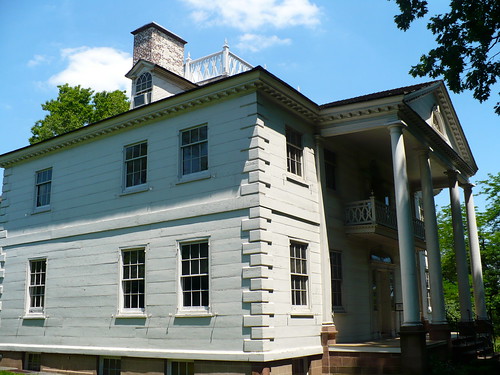
The oldest existing house in Manhattan has a colorful history. It started out as a summer house for Roger Morris, a British colonel. Later, it got used first by Washington then by British and Hessian military commanders as headquarters during the Revolutionary War. In 1790, Washington dined at the house with John Adams, Thomas Jefferson, John Quincy Adams, and Alexander Hamilton, among others. Twenty years later, a French wine merchant, Stephen Jumel, purchased it, and when he died, his wife, Eliza, married Aaron Burr. Their divorce was finalized the day Burr died. Who was Eliza Jumel's divorce lawyer? Alexander Hamilton, Jr.
In the neighborhood: Along the old carriage path to Morris-Jumel Mansion, you'll find the wooden 19th-century row houses of Sylvan Terrace. The mansion's gardens are also lovely. Other options in the area are High Bridge Park and the High Bridge, the oldest bridge in NYC and open only to pedestrians and bicyclists. From Morris-Jumel Mansion, you can also head west to Upper Trinity Cemetery and some of the other Washington Heights sites described below.
St. Paul's Chapel (Downtown)
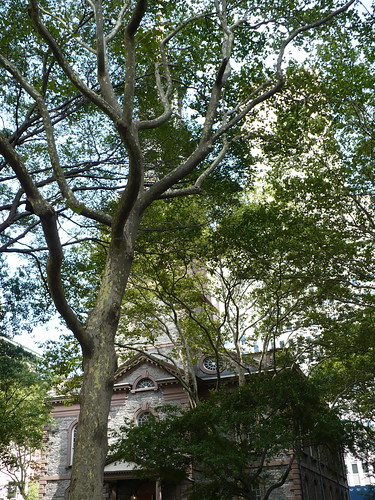
After his inauguration in 1789, Washington prayed at St. Paul's Chapel, and among the people buried in the churchyard is General Richard Montgomery. The chapel also played a role in more recent history, when in the months after the 9/11 attacks it became a base for rescue and recovery workers and clean-up crews to rest, eat, and receive comfort between shifts. It's located across the street from where the Twin Towers stood, and the trees in its yard kept it from damage by falling debris.
In the neighborhood: Along with the other Downtown sites listed here, visit the 9/11 Memorial and Museum.
Trinity Cemetery (Washington Heights)
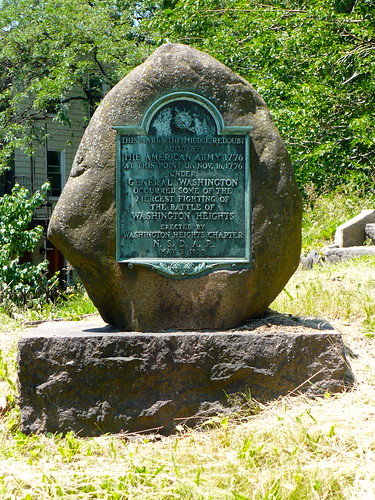
Among the people interred in this uptown cemetery are John James Audubon and Ralph Ellison. The cemetery was also the site of a Revolutionary War clash, the Battle of Fort Washington. The photo shows a marker for where the Continental Army set up one of its redoubts to try to hold off the British.
In the neighborhood: Just north of the cemetery is Audubon Terrace, where some of Anna Huntington Hyatt's magnificent sculptures are displayed, and where you can find both the Hispanic Society Museum and Library and the American Academy of Arts and Letters.
Trinity Churchyard (Downtown)
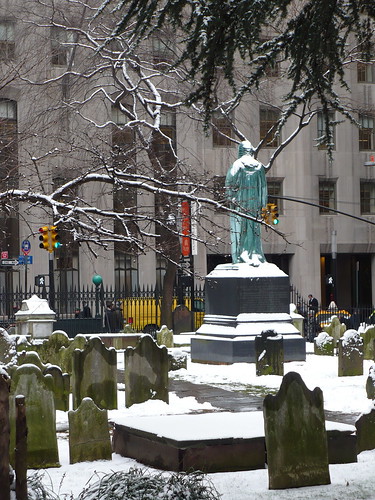
The historic Trinity Church faces Wall Street. The first church building on the site was destroyed in NYC's Great Fire of 1776, and the current structure dates from the mid-1800s. Alexander Hamilton, his wife, Eliza Schuyler Hamilton, and their oldest son, Philip, are all buried in the churchyard, among other historic figures, including Robert Fulton. (The statue in the photo isn't of any of them; it's John Watts.)
In the neighborhood: All the other Downtown sites mentioned in this post.
Wall Street Slave Market Plaque (Downtown)
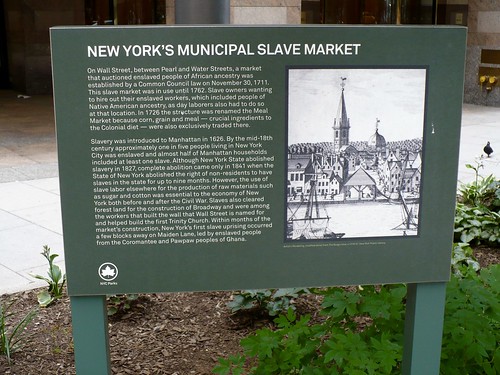
People often associate slavery with the southern US alone and forget the role of slaves and slave labor in the north. This plaque, which is set up on a patch of green space at the eastern end of Wall Street, speaks of an 18th century slave market in NYC. The text on the plaque can be found here.
In the neighborhood: This end of Wall Street is close to Pier 11, where you can take ferries to other locations (including Weehawken, New Jersey, where Alexander Hamilton and Aaron Burr dueled). You're also within walking distance of the other Downtown sites named in this post.
Queens
The Vander Ende-Onderdonk House (Ridgewood)
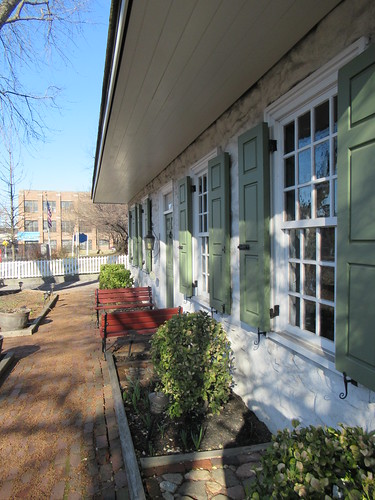
This is an old Dutch Colonial stone house built on land that was granted to the original owner by Peter Stuyvesant, the Dutch director-general of New Netherland. (He lost that post when the British arrived in 1664 to claim the area for themselves.) The Vander Ende-Onderdonk House is currently home to the Greater Ridgewood Historical Society.
In the neighborhood: Ridgewood is near Brooklyn's Bushwick neighborhood, where you'll find numerous art galleries and block after block of street art.
Staten Island
Conference House Park (Tottenville)
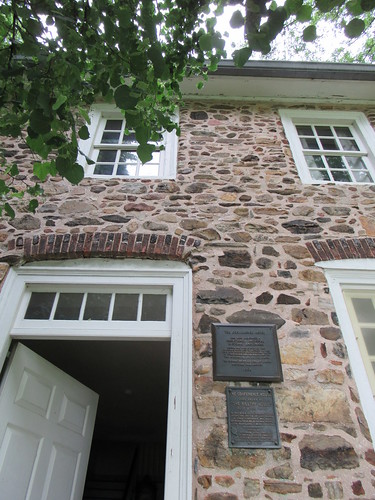
On September 11, 1776, the little-known Staten Island Peace Conference took place in this house, as Washington was clashing with the British over Manhattan. Admiral Richard Howe (the naval commander of the British and the brother of General William Howe) met with Ben Franklin, John Adams, and Edward Rutledge to discuss possible terms on which to end the war. The discussion fizzled quickly.
In the neighborhood: Conference House Park has a beach, trails, and other historic houses. But there's not much else in this neighborhood for visitors. It's a residential area. If you visit the park, you'll be able to say that you've been to the southernmost part of New York State. (A pole set up in the park is referred to as the "South Pole" of the state.)
Fort Wadsworth
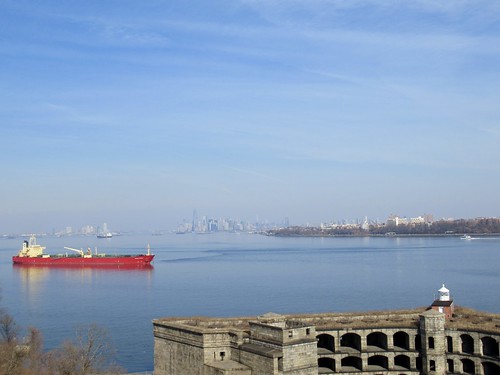
Located by the Verrazano-Narrows Bridge on the northeast shore of Staten Island, this site fell under British control during the American Revolution, and they built defensive structures on it. Because it overlooks the entrance to the NYC harbor, it was considered a strategic site. Here's an overview of its history after the Revolutionary War. To me, the most remarkable part of visiting the fort complex was the amazing view (the photo posted here shows Brooklyn, Manhattan, and the harbor). Just sit on a bench with your lunch and take in the view and the fresh air.
In the neighborhood: A little over a mile north is the Alice Austen House, a lovely photography museum. The St. Paul's Avenue Stapleton Heights Historic District is also worth exploring for its beautiful 19th and early 20th century homes. Another highlight in the northeast part of Staten Island is the Chinese Scholar's Garden at Snug Harbor.
Historic Richmond Town (Richmond)

Many of the buildings reconstructed and preserved in this museum and park date from the 19th century, but there are older structures, sites, and artifacts as well, such as Britton Cottage. (Also newer ones, like this diner built for the set of Boardwalk Empire.) Staten Island was strongly Loyalist at the start of the Revolutionary War, but the Loyalist sentiment weakened as the war - and the British occupation of the island - went on. Richmond Town was the site of a large British encampment.
In the neighborhood: Explore the nearby parks that belong to the Staten Island Greenbelt (like Latourette Park and High Rock Park). If you have an interest in Buddhism and in quiet gardens for meditation, visit the Jacques Marchais Museum of Tibetan Art, nestled among mansions on Lighthouse Hill. Lighthouse Hill is also where you'll find a house designed by Frank Lloyd Wright. It's called Crimson Beech. (But it's privately owned and not open to the public, so don't try sneaking in.)